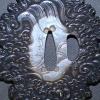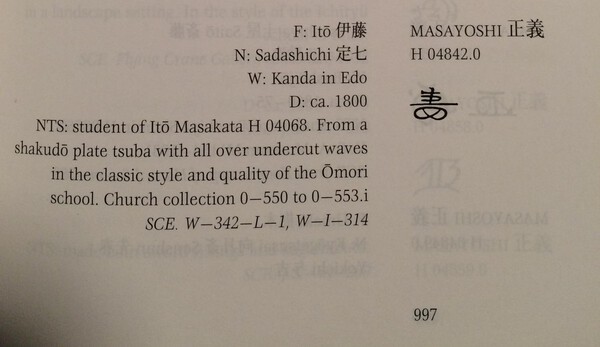-
Posts
802 -
Joined
-
Last visited
-
Days Won
3
Content Type
Profiles
Forums
Events
Store
Downloads
Gallery
Posts posted by Katsujinken
-
-
The garish polish on that blade was created to mislead – a caricature of Soshu, chikei, etc. – and the sayagaki is surely a forgery or shirasaya swap.
-
This was a fun one.
-
Those eBay mats cost about the same as what you could get from Nihonzashi, which would be a better choice because 1) you’d be supporting a local small business, and 2) you can get actual tatami omote or mugen dachi and not this mystery crap from eBay. :-P
-
 1
1
-
-
Jean is correct! In Japan, everyone using a shinken is using a traditionally made sword (supposedly...). Swords intended for iai and tameshigiri are often made with lower grade tamahagane or lack a fancy polish, etc., because they are bound to take some abuse. Here are some examples: https://www.e-sword.jp/category/iai/
¥350,000 is going to be the starting point for a decent shinsakuto not intended as an art sword. That may or may not include koshirae or the koshirae may or may not be suitable for iai. You'll definitely want to do your research and get an experienced practitioner who is familiar with nihonto to help you, when and if the time comes.
-
“Acceptable” depends on the price, the attribution... and you.
-
 2
2
-
-
Ken is right, the prices from resellers like Nihonzashi are ridiculous, but unless you are prepared to buy a shipping container (yes literally), fill it with tatami omote, and pay for all of the shipping and logistics, and store the container and thousands of mats once it arrives, you will pay upwards of $8 per mat after shipping.
My sword organization was able to do what I described above by pooling resources. That got the price per mat down to around $4... which is still infinitely more expensive than what it costs to cut in Japan ($0!).
It’s tough practicing an art that includes tameshigiri in America... even tougher in a big city. :-/
And by the way, I have only seen either mugendachi or tatami omote for sale. If you’re looking to insert green bamboo you’ll literally have to “roll your own.”
Good luck.
-
Contact Nihonzashi down in Florida. They may be able to help you out if you haven’t tried already.
-
Facts and fundamentals of Japanese swords and the art of the Japanese sword by Kapp and Yoshihara are a must have for beginners. Connoisseurs is cheap on ebay at the moment, last I saw it was $98 Australian dollars. Not many years ago it was around $300 if I remember correctly.
Greg
Connoisseur’s got a reprint not too long ago and is readily available for the cover price from Amazon (hurray).
-
 2
2
-
-
Must have: The Connoisseurs Book of Japanese Swords
https://www.amazon.com/dp/4770020716/ref=cm_sw_r_cp_api_i_2nivEbGVRQ5FB
-
 4
4
-
-
Gustaf, the mei is extremely fresh. The mei and the nakago have no appearance of age as you would expect from the Kamakura period. The sword is also katana-mei. The sugata, hamon, etc all have the feel of a much later work. There were a number of smiths who signed Kagemitsu, as indicated in my link above. Gimei is also possible.
Bingo bango bongo case closed. The mei and nakago look very young. Kamakura is totally out of the realm of possibility here.
-
They scream Masayoshi to me. Almost identical to a waki tsuba I bought from Grey a few years ago that came from the Haynes collection. I immediately gave it to someone as a gift so I have no photos, but perhaps if Grey sees this he can add one.
Ito Sadashichi Masayoshi worked in the Kanda neighborhood of Edo and died circa 1800.
-
6- uchiko should NEVER be used
Fixed that one for you.

-
 1
1
-
-
Yep, this one’s done for.
-
 1
1
-
-
Can anyone tell me if there will be a Shinza team at one of the US sword shows in 2020?
I have a sword or two to submit for Hozon.
Thank you, Charlie
NBTHK shinsa only takes place in Japan.
-
The shop is in Machida, about an hour outside of central Tokyo by train.
-
Mike Yamasaki of Tetsugendo is a top dealer and widely respected.
-
 1
1
-
-
I meant top left, sorry (I was on mobile). So the right one looks too warm to my eyes.
The best thing to do is to use a white balance card to color correct in post.
https://www.amazon.com/dp/B004G3NW5M/ref=cm_sw_r_cp_api_i_XLjPDb0TYWD3Q
-
 1
1
-
-
The temperature and tones of the top one look more accurate to me. The bottom one seems too warm.
-
Absolutely. Under $400 with NBTHK papers? No brainer if the piece appeals to you! Congrats.
-
 1
1
-
-
ZCorr is now BluGuard, I believe. Search for that instead.
-
It’s probably overkill in my climate, but I also like the ZCorr (now BluGuard) product.
-
I don’t know whether to laugh or cry.
-
 2
2
-
-
Michael, I'm afraid that what is taught as "kenjutsu" these days is little more than dancing with a sword. I've visited other dojo where no one was correcting really horrible mistakes, including what the "sensei" was doing. Thank goodness our Sensei made us describe what we were doing, for every step in each waza, & if we couldn't tell him precisely which virtual tekki we were striking, where on the body, & why, we failed! So, tameshigiri was fairly straightforward when I got to it, because it was a logical application of what I'd already learned.
And that’s exactly what it should be. Tameshigiri as bunkai!
Kata without bunkai, motivation, and real storytelling vis a vis tekki, is, like you said, dancing. Sigh...
-
 1
1
-
-
I agree, but the cuts are almost always changed quite a bit! Wife & I also train in Jodo, & our Menkyo Kaiden Sensei asked me to set up a tameshigiri demonstration, after which, everyone else wanted to try (of course). My shinken got quite a workout, mostly because no one seemed able to make a decent kesagiri cut, let alone nukitsuke, in tatami omote! The concept of hasuji is seldom taught, these days, & iaidoka think that just because they can get a loud tachikaze, they're cutting correctly. Those are the ones who "scoop" through the tatami, because they aren't cutting through the target, no matter how many times I corrected them. Ah, well.
Hear, hear Ken. You can’t truly learn tenouchi or hasuji without cutting something. And nukitsuke? Pure fantasy unless you’ve learned to make it cut. Here in New York City logistics make tameshigiri more of a diagnostic tool than finely honed skill, but I can’t imagine practicing kenjutsu without it.
-
 1
1
-




Oldest piece of Japanese art
in General Nihonto Related Discussion
Posted